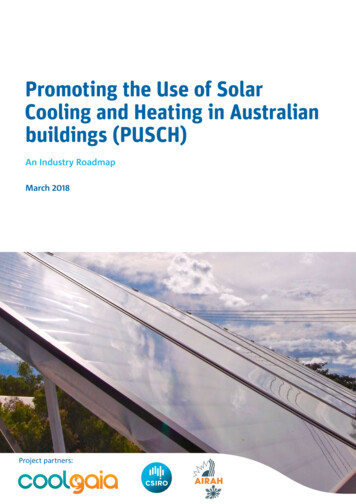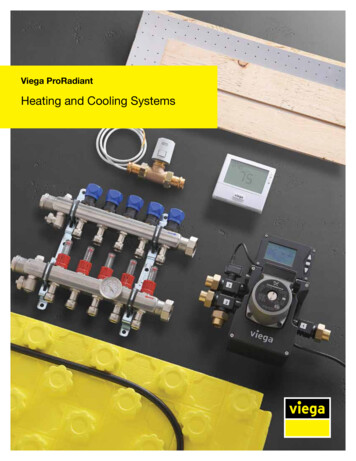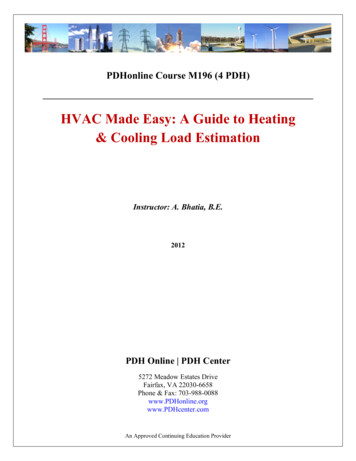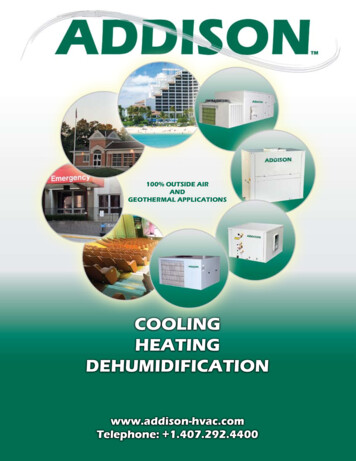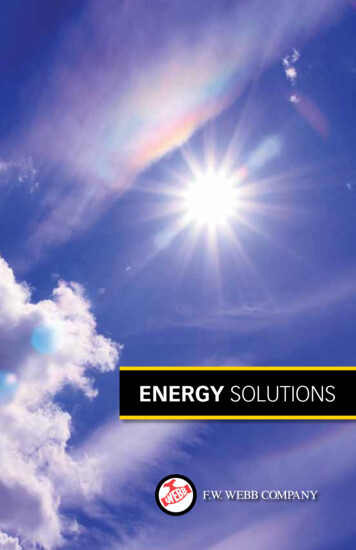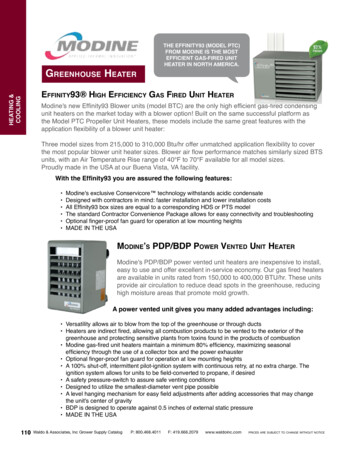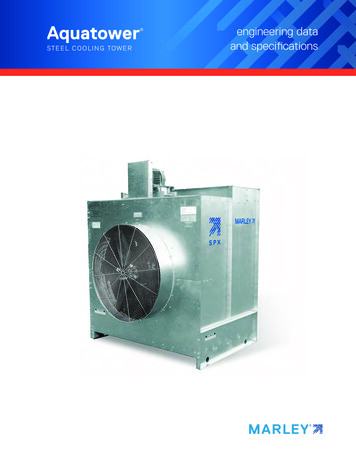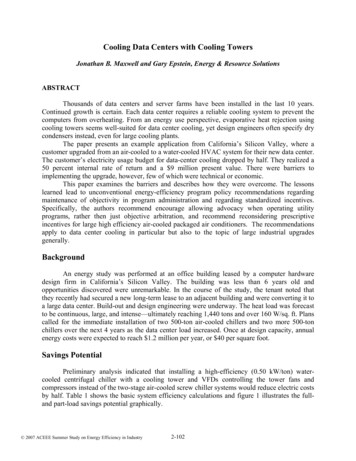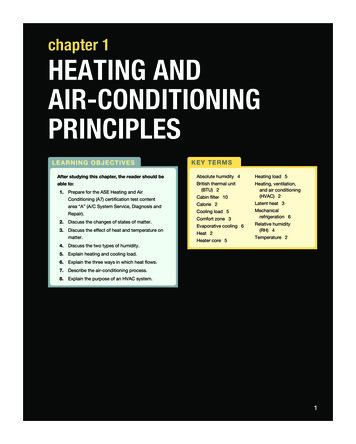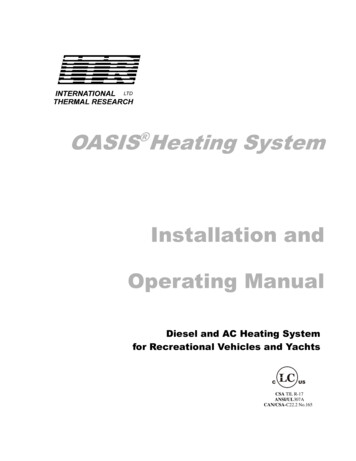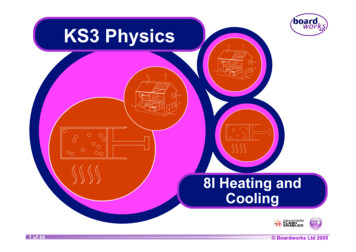
Transcription
KS3 Physics8I Heating andCooling1 of 2044 Boardworks Ltd 20052004
Contents8I Heating and CoolingHeat and temperatureConduction and convectionRadiationChanges of state and evaporationSummary activities12 of 2044 Boardworks Ltd 20052004
What is heat?Heat is a type of energy.Heat is the name for the type of kinetic energy possessedby particles.Heat energy is measured in joules (J).How many joules are there in a kilojoule (kJ)?If something gains a lot of heat energy, it becomes hot– so what is temperature?13 of 2044 Boardworks Ltd 20052004
What is temperature?Temperature is a measure of how hot or cold an object is.(It is not the total amount of energy contained in the object.)Temperature is measured in degrees Celsius (ºC).The freezing point of water is defined as 0ºC (at 1 atm.).The boiling point of water is defined as 100ºC (at 1 atm.).Temperature can be measured by a variety of differentthermometers. These include liquid in glass, digital,thermocouple and bimetal strip thermometers.14 of 2044 Boardworks Ltd 20052004
Heat transferThe correct phrase for heat transfer is ‘thermal transfer’.Heat energy can be transferred (moved) by four processes:1. conduction2. convection3. evaporation4. radiationIn each process, thermal energy is also transferred in the way:HOTCOLDHeat energy only flows when there is a temperature difference.15 of 2044 Boardworks Ltd 20052004
The particle modelThe differences between solids, liquids and gases can beexplained by the particle model:1. All substances are made up of particles (atoms, ions ormolecules).3. These particles are attracted to each other, some stronglyand others weakly.4. These particles move around (i.e. have kinetic energy).5. The kinetic energy of particles increases with temperature.16 of 2044 Boardworks Ltd 20052004
Temperature and energyWhat happens to the gas as the temperature increases?Would this be the same for solids and liquids?17 of 2044 Boardworks Ltd 20052004
Contents8I Heating and CoolingHeat and temperatureConduction and convectionRadiationChanges of state and evaporationSummary activities18 of 2044 Boardworks Ltd 20052004
Conduction experimentConduction of heat in different materials can be investigatedin an experiment.Apparatus:8 cm strip of copper8 cm piece of woodBunsen burnerstopwatchblob of waxTake care whilst doing this experiment:l Wear safety glasses.l Do not touch mot metal objects!l Wash any burn with cold water for ten minutes.19 of 2044 Boardworks Ltd 20052004
Conduction experimentl Add a blob of wax to one end of thecopper and hold the other end in theyellow Bunsen flame.l How long does it take for the wax tomelt and drop off the metal strip?l Now do the same for wood.l Why are the times very different?110ofof2044 Boardworks Ltd 20052004
Conduction in metalsMetals are good conductors of heat because:l Metals have atoms inside them and lots offree electrons.l The free electrons can move aroundand vibrate.l The heat energy is passed on by neighbouringparticles vibrating along the metal.111ofof2044 Boardworks Ltd 20052004
Conduction – compare a metal and a non-metalWhich material feels warmer if you touch a piece of woodand a piece copper metal, both at room temperature(i.e. both at 25ºC)?The wood feels warmer because it is a poor conductor.It cannot conduct heat away from your hand as quickly asthe copper which is a good conductor.112ofof2044 Boardworks Ltd 20052004
Conduction in non-metalsNon-metals are poor conductors of heat.In a non-metal, heat energy is only passed on by neighbouringparticles vibrating along the non-metal (no free electrons).This allows a flow of energy from hot to cold.113ofof2044 Boardworks Ltd 20052004
Conduction in liquidsMetals are good conductors of heat and non-metals arepoor conductors of heat (insulators).Are liquids good at conducting heat?l Use some gauze to hold anice cube at the bottom of atube of water.l Carefully heat the water atthe top of the tube only,until this water is boiling.100ºC0ºCl If the liquid is good atconducting, the ice shouldquickly melt – it doesn’t.l Liquids are poor conductors of heat (i.e. good insulators).114ofof2044 Boardworks Ltd 20052004
Conduction in gasesLiquids are poor conductors of heat (good insulators).Are gases good at conducting heat?l Carefully hold a safety match1 cm away from a Bunsenburner flame. (Do not put thematch in the flame!)l If a gas is a good conductor, theair between the flame and thematch should conduct heat andlight the match – it doesn’t.l Gases are poor conductors of heat (i.e. good insulators).115ofof2044 Boardworks Ltd 20052004
Conduction – summary table116ofof2044MaterialConductor or Insulator?metalsvery good esgood insulatorsvacuumexcellent insulator Boardworks Ltd 20052004
Convection and densityTo understand how heat can be transferred by convection, theidea of density is important.If water, oil and air are mixedup, they will settle out in orderof density – which one willrise to the top?The air is least dense and risesto the top, the water is themost dense and sinks to thebottom – it depends on howfar apart the particles are.117ofof2044 Boardworks Ltd 20052004
Convection current in a liquidThe movement of hotter areas in a liquid can be seen usingpotassium permanganate as a dye:This cycle is called aconvection current.heatheatCan you explain how the convection current moves usingthe idea of density?118ofof2044 Boardworks Ltd 20052004
Convection current in a gasConvection currents cannot occur in solids because theparticles are held in fixed positions – but can they occurin gases?l Place a candle at one sideof a litre beaker.l Place a piece of card downthe centre, leaving a gap of2cm at the bottom.l Make some smoke withsmouldering spills andwatch the path of the smoke.Can you explain why this happens?119ofof2044 Boardworks Ltd 20052004
Convection currents in coal minesWhen shaft mining was first used to mine coal,convection currents caused by an underground firewere used to ventilate the shafts:Why do you think miners don’t use this method anymore?120ofof2044 Boardworks Ltd 20052004
Convection currents in a pan of boiling water121ofof2044 Boardworks Ltd 20052004
Contents8I Heating and CoolingHeat and temperatureConduction and convectionRadiationChanges of state and evaporationSummary activities122ofof2044 Boardworks Ltd 20052004
RadiationHeat can move by travelling as infrared waves.These are electromagnetic waves, like light waves,but with a longer wavelength.This means that infrared waves act like light waves:l They can travel through a vacuum.l They travel at 300,000,000 m/s.l They can be reflected.l They cannot travel through opaque materials.123ofof2044 Boardworks Ltd 20052004
Radiation experiment – instructionsPaint four thermometer bulbs with the following colours:blackwhitesilverredl Place each thermometer into very hot waterfor one minute.l Take it out of the water, start the stopwatchand read the temperature.l Read the temperature every 30 seconds andrecord the results in a table.124ofof2044 Boardworks Ltd 20052004
Radiation experiment – results table00.511.522.533.54TempColour min min min min min min min min min changeblackwhiteWhitesilverredWhich colour of the thermometer bulb radiated most heat?125ofof2044 Boardworks Ltd 20052004
Radiation experiment – results analysisEither:a) Draw a bar chart of your results.Put temperature change on the y axisand colour on the x axis.Or:b) Draw a line graph of your results.Put temperature on the y axisand time on the x axis.Draw four lines on the graph, one for each colour.126ofof2044 Boardworks Ltd 20052004
Radiation investigationA cup of tea takes up to 30 minutes to go cold.This depends on the colour and shape of the cup.Design an investigation to find out the best shape andcolour of a cup to keep tea warm for longer.127ofof2044 Boardworks Ltd 20052004
Contents8I Heating and CoolingHeat and temperatureConduction and convectionRadiationChanges of state and evaporationSummary activities128ofof2044 Boardworks Ltd 20052004
States of matter and temperatureWater can be a solid, liquid or gas.l At a cold enough temperature, even substances thatare normally gases will become solid.l At higher temperatures, solids change to becomeliquids or gases – as long as they don’t catch fireor decompose first.129ofof2044 Boardworks Ltd 20052004
Changes of stateEach change of state is given a different ascondensing Boardworks Ltd 20052004
Changes of state activity131ofof2044 Boardworks Ltd 20052004
Changes of state – heating curveIf a solid is heated, its temperature rises until it reachesthe melting point of the solid.At the melting point, the temperature stops rising whilst thesolid melts. This is because heat energy is going intoseparating the particles rather than raising the temperature.Once all the solid has melted, the temperature starts torise again until it reaches the boiling point.At the boiling point the temperature again stays the same asenergy goes into further separating the particles.132ofof2044 Boardworks Ltd 20052004
Changes of state – heating curvetemperatureboiling liquid gasmelting condensing solid liquidfreezing time133ofof2044 Boardworks Ltd 20052004
Changes of state – cooling curve activity134ofof2044 Boardworks Ltd 20052004
What is evaporation?Evaporation occurs when the particles in a liquid escapeto form a vapour.Evaporation can occur at any temperature but it occursmost rapidly at a liquid’s boiling point.The particles that escape take some energy from theremaining particles and so the temperature of the liquid falls.Evaporation is another method of heat transfer.135ofof2044 Boardworks Ltd 20052004
Evaporation experimentEvaporation from different liquids can be investigatedusing this experiment:l Take four equal masses of cotton wooland soak each one in a different liquid– ethanol, water, propanol andoctanol.l Wrap each piece of cotton woolaround the bottom of a thermometerand secure it with a rubber band.l Read the temperature every0.5 minutes and record theresults in a table.136ofof2044 Boardworks Ltd 20052004
Evaporation experiment – results tableLiquidTemp.change0 0.5 1.0 1.5 2.0 2.5 3.0(ºC)min min min min min min minTemperature (ºC)ethanolwaterpropanoloctanol137ofof2044 Boardworks Ltd 20052004
Evaporation experiment – results analysisEither:1. Draw a bar chart of your results.Put temperature change on the y axis.Put type of liquid on the x axis.Or:2. Plot a line graph of your results.Put temperature on the y axis.Put time on the x axis.Plot four lines, one for each liquid.Are any of the results anomalous?138ofof2044 Boardworks Ltd 20052004
Contents8I Heating and CoolingHeat and temperatureConduction and convectionRadiationChanges of state and evaporationSummary activities139ofof2044 Boardworks Ltd 20052004
Glossaryl conduction – The way that heat energy travels throughsolids because their particles are close together.l conductor – A material that allows heat energy to flowthrough it.l convection – The way that heat energy travels throughliquids and gases because their particles are free to move.l heat – A form of energy, measured in joules (J).l heating – The transfer of heat energy.l insulator – A material that does not allow heat energy toflow through it.l radiation – The transfer of heat energy by electromagneticwaves, and which does not need a medium.l temperature – How hot or cold an object is, measured indegrees Celsius ( C).140ofof2044 Boardworks Ltd 20052004
Anagrams141ofof2044 Boardworks Ltd 20052004
Heat transfer questions1. How does a cup of tea lose heatby conduction, convection,evaporation and radiation?2. Why does take-away food oftencome in aluminium containers?3. Why do elephants have big ears?142ofof2044 Boardworks Ltd 20052004
Heat transfer – energy lossesName the three processesthat cause energy to belost from the home.Which areas of the houselose energy?What can be done toprevent this energy loss?143ofof2044 Boardworks Ltd 20052004
Multiple-choice quiz144ofof2044 Boardworks Ltd 20052004
1 of 2010 of 44 Boardworks Ltd 2004 Boardworks Ltd 2005 ! Add a blob of wax to one end of the
